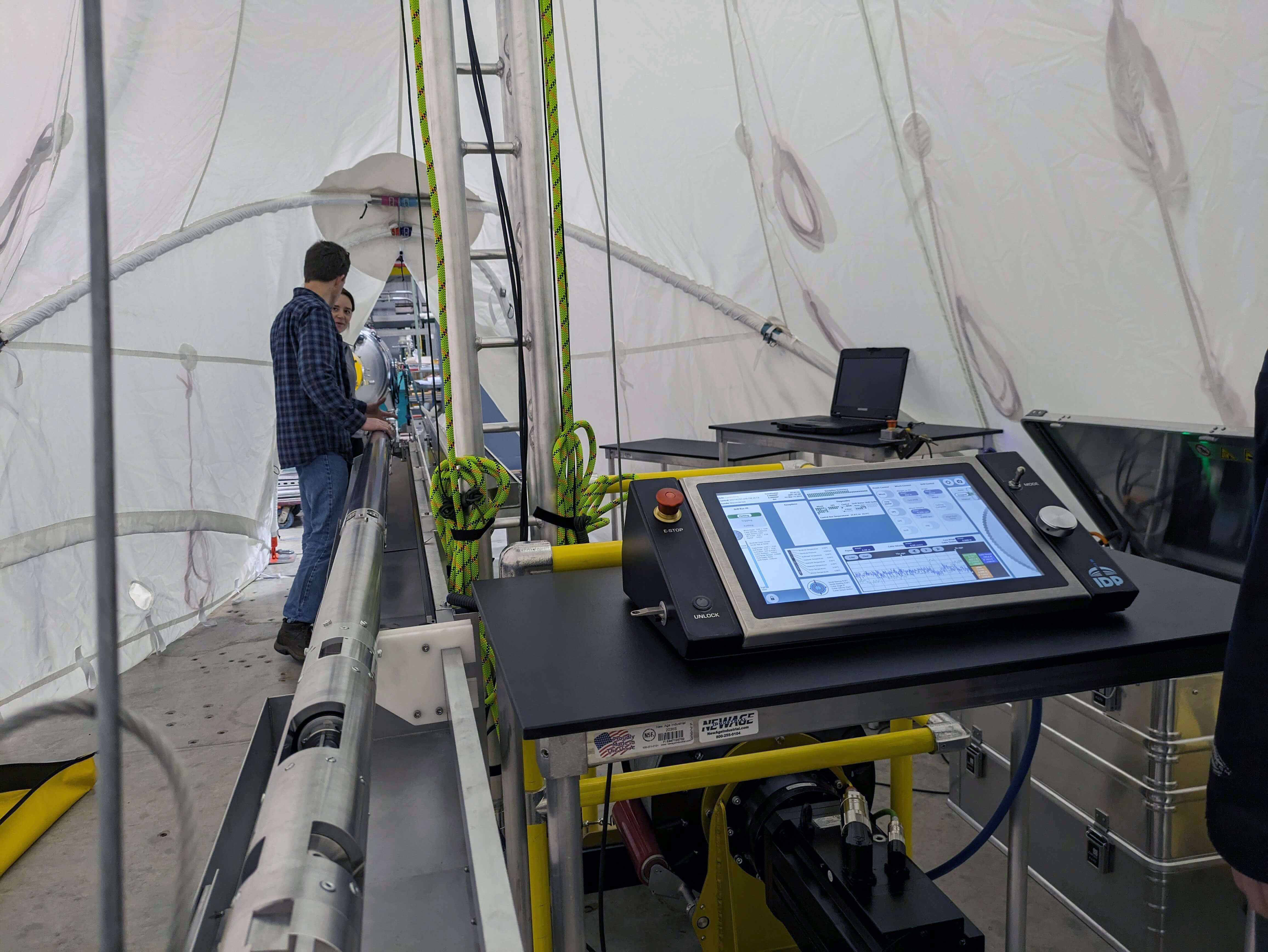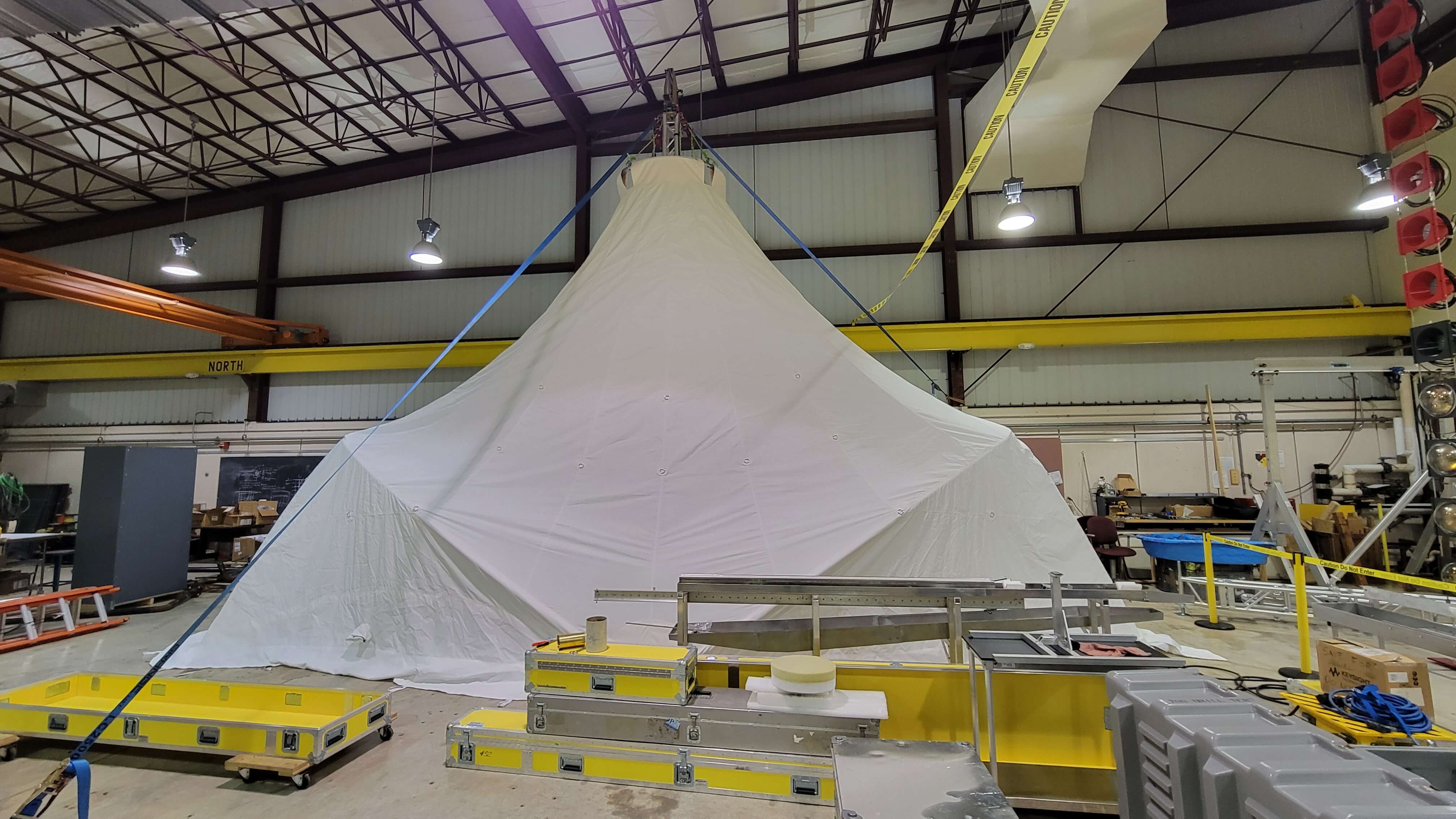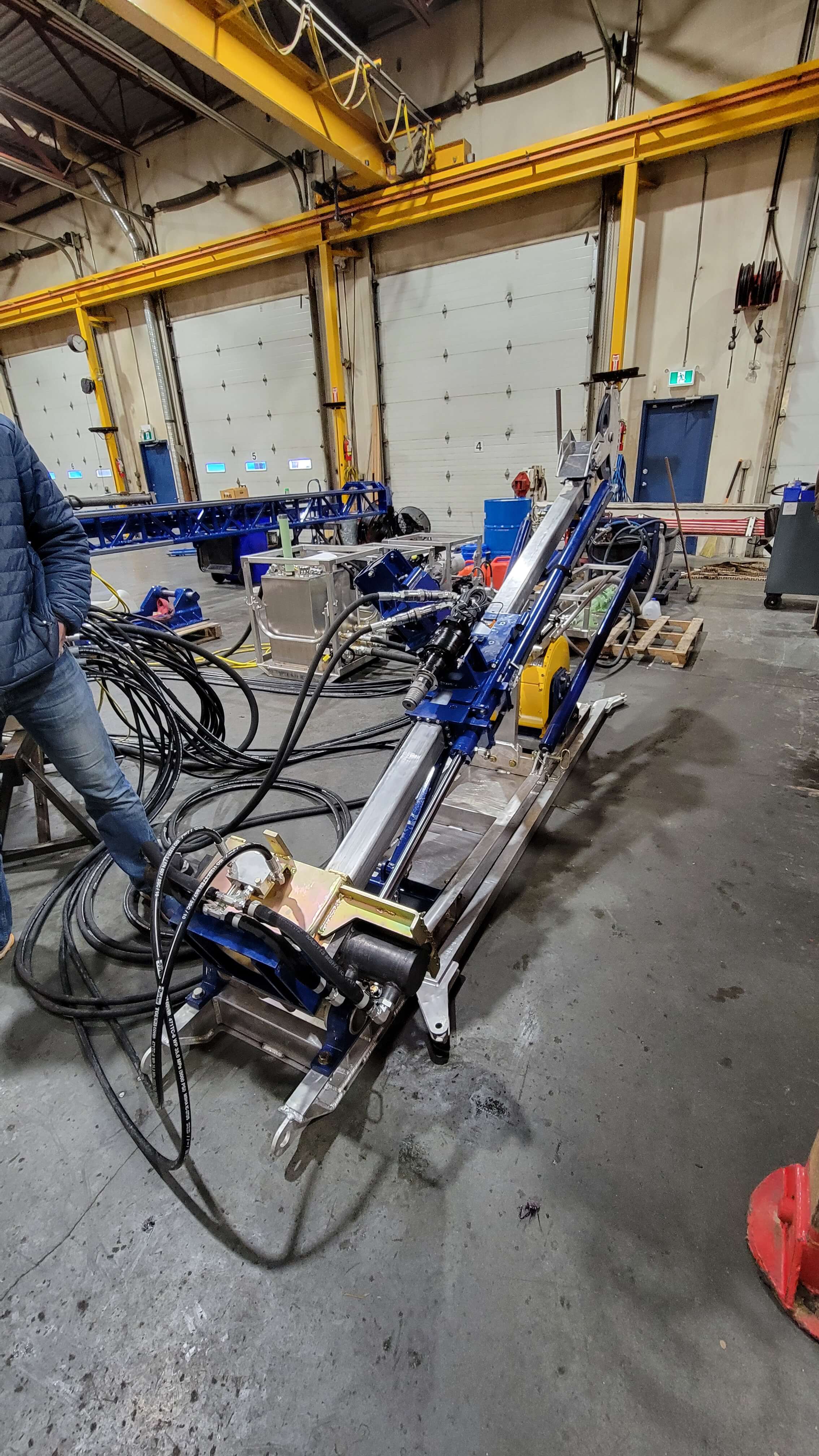In February and March, IDP engineers spent some time at the UW-Madison Physical Sciences Lab (PSL), putting the 700 Drill winch and control system through its paces. The winch and tower were set up over a cased hole in the ground, and a portion of the drill sonde and a weight were attached to the cable. IDP Electrical Engineer Umberto Stefanini spent several days inside an Eskimo work tent working to test and troubleshoot the control system. Following the outdoor testing, the drill tent was set up inside an adjacent facility at PSL. In April, the drill was set up at the IDP facility to facilitate final in-house testing of the control software, slide rail assembly for laying the drill down, and the core handling and chips/fluid handling trays and assemblies. The drill was disassembled in late April, and packing began for shipment to Scotia, NY, in early May. The drill will be tested and used at Summit Station in June and July to support PI Eric Saltzman’s project.
700 Drill
New 700 Drill System Ready for Action
Drill Development and Maintenance/Upgrade News
Development of the 700 Drill continued at an excellent pace. The control box and console wiring were completed, and the control box was powered up and tested. The design of the chip bailer continued, and sonde components like the outer tube, hollow shaft, and core barrel were fit-checked. IDP met with personnel at the UW Physical Sciences Lab (PSL) to coordinate the testing of subsystems in the PSL test well. Work continued on the sonde electronics. The motor torque test stand was assembled, and engineers immediately began gathering and analyzing data. Orders were placed for core processing and fluid handling system components. The drill cable was successfully spooled onto the winch. The first use of the 700 Drill is scheduled for the summer of 2024 in support of PI Eric Saltzman’s molecular hydrogen (H2) project (NSF award 2243540) at Summit, Greenland.
The Engineering Requirements document for the BASE (Basal Access and Subglacial Exploration) Drill system was finalized and approved. Drill rod was ordered and received. Jay Johnson and Elliot Moravec traveled to Multi-Power Products Ltd in Kelowna, BC, in February for drill acceptance and operational training. IDP expects to receive the drill in Madison, WI, in March or April, and will work to design the auxiliary components for use of the drill in ice in the polar regions.
In preparation for the second GreenDrill season, a level wind option was purchased for the Agile Sub-Ice Geological (ASIG) Drill, as well as Kubota engine spares, drill rod end caps, rod scraper rings, Geoblock for the drill tent and generator tent flooring, and a replacement flow jet pump. IDP engineers also worked to design improvements for the ASIG Drill chip handling and filtration system. The Winkie Drill packer and the water swivel seal were tested, and filter socks, casing centralizers, and full-face and impregnated bits were purchased. Additional Winkie Drill casing was ordered and received to account for GreenDrill firn depth uncertainty, and work on a new insulated filtration tank was completed.
Work continued on new outer tubes for the Foro 400 Drill, and components for a new truss tower were received.
Drill Development and Maintenance/Upgrade News
Assembly of the new 700 Drill is in full swing at IDP in Madison, WI. Mechanical assembly of the sonde is nearly complete, from the anti-torque section down to the cutter head. The control box and console are currently being wired, and electronics testing is underway. Shipping cases were ordered and received, and designs for the core handling and fluid/chips processing systems are now complete.
IDP Engineers revisited the Deep Logging Winch to mitigate electromagnetic interference (EMI) issues previously witnessed in the field with several logging tools provided by community scientists. Through careful investigation and comparison with a winch at the UW Physical Sciences Lab, noise and communication lapses have been successfully mitigated by installing two filters and cleaning of slip ring contacts. The winch is now ready for issue.
Good progress is being made in preparing the Winkie and ASIG drills for the second season of the GreenDrill project in northeast Greenland in spring 2024. Maintenance was completed on the Winkie Drill packer and drive head and air compressors for the Winkie and ASIG drills. New core barrel components were ordered, received, and tested for the Winkie Drill to improve clearances when drilling in clay and mixed media, and a new slip foot clamp was implemented and tested.
New 700 Drill Takes Shape
Over the past ten months, IDP electrical and mechanical engineers have worked hard to bring the detailed designs for the 700 Drill to life. Equipment designs were finalized, engineering drawings completed, components ordered, and assembly begun. The winch and tower were fully assembled in Madison, and the electronics hardware and software also made excellent progress. Control system mechanical and electrical features were finalized, and work was initiated on final auxiliary systems such as core handling and chips processing equipment. IDP anticipates the drill will be ready for issue by March 2024.
700 Drill Fabrication Approved
The IDP Science Advisory Board identified in the IDP Long Range Science Plan 2015-2025 and later, a priority need to envision and develop a drilling operation that is less logistically intensive than the existing Foro 1650 Drill (formerly referred to as the Intermediate Depth Drill or IDD), to be used to retrieve ice cores from 700 m depth at alpine or polar ice coring sites with limited logistics and with two months or less time on site. In continuing discussions, it became evident that a smaller diameter core than the Foro drills produce (e.g., 98 mm) would result in significant logistical savings.
From discussions organized by IDP with iterative discussions between scientists, and IDP staff, the 700 Drill Science Requirements were finalized, a Conceptual Design was created, a Conceptual Design Review was completed, a Detailed Design was developed, and a Detailed Design Review was completed. The proposed 700 Drill system design is guided by and meets the science requirements identified by the research community. The system will be optimized to have minimal logistical requirements for drilling projects up to 700 meters in depth. The 700 Drill will produce a 70 mm diameter core (potentially adapting to 64 mm in the future) and 88 mm diameter borehole, which will minimize the quantity (i.e., volume and weight) of drilling fluid and the number and weight of core boxes. With NSF approval, IDP is now moving forward with the construction of the drill, currently slated for completion in February 2024.
IDP-WI Equipment Development and Maintenance Update
The third large compressor for IDP’s Rapid Air Movement (RAM) Drill received new plastic on its skis prior to shipment to Port Hueneme, CA, in mid-November. The compressor will travel on the resupply vessel to McMurdo Station, Antarctica, where it will be stored as a spare for the upcoming GHOST project (PI Anandakrishnan) on Thwaites Glacier.
Over the summer, the UW-Madison Space Science and Engineering Center (SSEC) secured additional space for IDP at the drill maintenance and warehouse facility. IDP’s electronics lab has been relocated to the new space, where the Foro 3000 and Foro 1650 Drill (previously referred to as the Intermediate Depth Drill or IDD) electronics are undergoing testing.
In preparation for the Detailed Design Review of the 700 Drill held on November 18, IDP engineers set up the Foro 400 Drill tent. The team believes a tent of very similar design could be used with the new drill slated to drill to 700 meters if fabrication is approved. A preliminary model of the 700 Drill subsystems can be seen below.
700 Drill Detailed Design Progress
Following NSF approval, IDP Engineers have now moved into the Detailed Design phase for the 700 Drill. The drill design is guided by and meets the science requirements identified by the research community. The small-diameter ice coring system will operate in a fluid-filled borehole to collect ice cores down to 700 m depth, all while minimizing logistics as much as possible. The 700 Drill will produce a 70 mm diameter core (potentially adapting to 64 mm in the future) and 88 mm diameter borehole, which will minimize the quantity (i.e., volume and weight) of drilling fluid and the number and weight of core boxes. IDP plans to hold an external design review with community scientists, ASC personnel, and the NSF in early PY 2022.
700 Drill
The IDP Science Advisory Board identified in the IDP Long Range Science Plan 2015-2025, and later, a priority need to alter the surface equipment for the existing Foro 1650 (Intermediate Depth Drill) to make a drilling operation that is less logistically intensive, to be used for alpine or polar ice coring at sites with limited logistics and with two months or less time on site. In continuing discussions, it became evident that a smaller diameter core would result in significant logistical savings. From discussions organized by IDP with iterative discussions between scientists, and IDP staff, the 700 Drill science requirements were finalized, and a Conceptual Design Review was also completed. The proposed 700 Drill system design is guided by and meets the science requirements identified by the research community. The system will be optimized to have minimal logistical requirements for drilling projects up to 700 meters depth. The proposed 700 Drill system will produce the smallest core diameter (70 mm initially, potentially adapting to 64 mm in the future) and borehole diameter (88 mm) of the IDP suite of drills, which will minimize the quantity (i.e., volume and weight) of drilling fluid and the number and weight of core boxes. Pending NSF approval, IDP will move forward with the Detailed Design phase for the 700 Drill and, when completed, will present the design to community scientists and NSF for review.




















